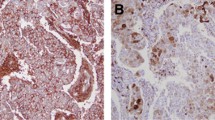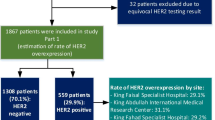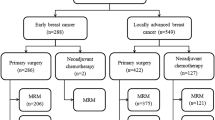Abstract
CD44 + /CD24 − phenotype has been associated with stem cell-like characteristics with enhanced invasive properties, radiation resistance, and with distinct genetic profiles suggesting a correlation to adverse prognosis in western literature. The aim of this study was to study CD44 + /CD24 − phenotype as an adverse prognostic marker in Indian breast cancer patients. N = 61 breast cancer patients included in a tertiary care facility in India were evaluated for receptor studies (estrogen receptor ER, progesterone receptor PR, Herceptin antibody Her2 neu receptor, CD44 & CD24 stem cell markers). CD44 + /CD24 − phenotype was statistically related to adverse factors like estrogen and progesterone receptors non-expression, her 2 neu expression, and triple-negative breast cancer. Of the 39 patients with ER-ve status, 33 (84.6%) were found to have CD44 + /CD24 − phenotype and 82.5% of all the CD 44 + /CD24 − patients were ER negative (p = 0.001). Thirty-four (75.5%) of the PR-ve patients showed the CD44 + /CD24 − phenotype, and of all the CD 44 + /CD24 − patients, 85% of were PR negative (p = 0.006). Thirty-six (75%) of Her-2-Neu + ve were CD44 + /CD24 − . Approximately 90% of the Her 2 Neu patients expressed CD44 + /CD24 − and 76.9% of all the triple-negative patients were found to be CD44 + /CD24 − expression (p = 0.001). CD44 + /CD24 − had a significant association with adverse prognostic factors like stage of disease, hormonal receptor status, and molecular subtypes in Indian breast cancer patients like the Western data.
Similar content being viewed by others
References
Raouf A, Zhao Y, To K, Stingl J, Delaney A, Barbara M et al (2008) Transcriptome analysis of the normal human mammary cell commitment and differentiation process. Cell Stem Cell 3:109–118
Ghebeh H, Sleiman GM, Manogaran PS, Al-Mazrou A, Barhoush E, Al-Mohanna FH et al (2013) Profiling of normal and malignant breast tissues how CD44high/CD24low phenotype as a predominant stem/progenitor marker when used in combination with Ep-CAM/CD49f markers. BMC Cancer 13:289
Morel AP, Lievre M, Thomas C, Hinkal G, Ansieau S, Puisieux A (2008) Generation of breast cancer stem cells through epithelial-mesenchymal transition. PLoS One 3(8):e2888. https://doi.org/10.1371/journal.pone.0002888
Allred DC, Harvey JM, Berardo M, Clark GM (1998) Prognostic and predictive factors in breast cancer by immunohistochemical analysis. Mod Pathol 11(2):155–168
Harvey JM, Clark GM, Osborne CK, Allred DC (1999) Estrogen receptor status by immunohistochemistry is superior to the ligand-binding assay for predicting response to adjuvant endocrine therapy in breast cancer. J Clin Oncol 17(5):1474–1481. https://doi.org/10.1200/JCO.1999.17.5.1474
Bane A, Viloria-Petit A, Pinnaduwage D, Mulligan AM, O’Malley FP, Andrulis IL (2013) Clinical–pathologic significance of cancer stem cell marker expression in familial breast cancers. Breast Cancer Res Treat 140:195–205. https://doi.org/10.1007/s10549-013-2591-1
Taylor VJ, Barnes PJ, Godwin SC et al (2021) Assessment of HER2 using the 2018 ASCO/CAP guideline update for invasive breast cancer: a critical look at cases classified as HER2 2+ by immunohistochemistry. Virchows Arch 479:23–31. https://doi.org/10.1007/s00428-021-03034-4
Tang P, Tse GM (2016) Immunohistochemical surrogates for molecular classification of breast carcinoma: a 2015 update. Arch Pathol Lab Med 140(8):806–814. https://doi.org/10.5858/arpa.2015-0133-RA
Tulsyan S, Agarwal G, Lal P, Agarwal S, Mittal RD, Mittal B (2013) CD44 gene polymorphisms in breast cancer risk and prognosis: a study in North Indian population. PLoS One 8(8):e71073. https://doi.org/10.1371/journal.pone.0071073
Lin Y, Zhong Y, Guan H, Zhang X, Sun Q (2012) CD44+/CD24- phenotype contributes to malignant relapse following surgical resection and chemotherapy in patients with invasive ductal carcinoma. J Exp Clin Cancer Res 31(1):59. https://doi.org/10.1186/1756-9966-31-59
Abraham BK, Fritz P, McClellan M, Hauptvogel P, Athelogou M, Brauch H (2005) Prevalence of CD44+/CD24−/low cells in breast cancer may not be associated with clinical outcome but may favor distant metastasis. Clin Cancer Res 11(3):1154–1159
Perrone G, Gaeta LM, Zagami M, Nasorri F, Coppola R, Borzomati D et al (2012) In situ identification of CD44+/CD24- cancer cells in primary human breast carcinomas. PLoS One 7(9):e43110. https://doi.org/10.1371/journal.pone.0043110
Sheridan C, Kishimoto H, Fuchs RK, Mehrotra S, Bhat-Nakshatri P, Turner CH et al (2006) CD44+/CD24- breast cancer cells exhibit enhanced invasive properties: an early step necessary for metastasis. Breast Cancer Res 8(5):R59
Wu Y1, Sarkissyan M, Elshimali Y, Vadgama JV (2013) Triple negative breast tumors in African-American and Hispanic/Latina women are high in CD44+, low in CD24+, and have loss of PTEN. PLoS One 8(10):e78259. https://doi.org/10.1371/journal.pone.0078259. eCollection 2013
Ricardo S, Vieira AF, Gerhard R, Leitão D, Pinto R, Cameselle-Teijeiro JF et al (2011) Breast cancer stem cell markers CD44, CD24 and ALDH1: expression distribution within intrinsic molecular subtype. J Clin Pathol 64(11):937–946. https://doi.org/10.1136/jcp.2011.090456
Ma F, Li H, Wang H, Shi X, Fan Y, Ding X et al (2014) Enriched CD44(+)/CD24(-) population drives the aggressive phenotypes presented in triple-negative breast cancer (TNBC). Cancer Lett 353(2):153–159. https://doi.org/10.1016/j.canlet.2014.06.022
Kim HJ, Kim MJ, Ahn SH, Son BH, Kim SB, Ahn JH et al (2011) Different prognostic significance of CD24 and CD44 expression in breast cancer according to hormone receptor status. Breast 20(1):78–85. https://doi.org/10.1016/j.breast.2010.08.001
Chen Y, Song J, Jiang Y, Yu C, Ma Z (2015) Predictive value of CD44 and CD24 for prognosis and chemotherapy response in invasive breast ductal carcinoma. Int J Clin Exp Pathol 8(9):11287–11295
Allred DC, Harvey JM, Berardo M (1998) Prognostic and predictive factors in breast cancer by immunohistochemical analysis. Mod Pathol 11:155–168
Dias K, Dvorkin-Gheva A, Hallett RM et al (2017) Claudin-low breast cancer; clinical & pathological characteristics. PLoS One 12(1):e0168669. https://doi.org/10.1371/journal.pone.0168669
Author information
Authors and Affiliations
Contributions
AkA, S. K., and A. A. S. designed the study. J. L. M., AkA, and K. R. S. were involved in acquisition of data. J. L. M., AkA, K. R. S., and N. H. did the analysis of data. K. G. and AkA drafted the manuscript. A. A. S., M. A., and S. K. critically revised and approved the final draft. AkA, P. A., and A. A. were involved in critical revision and manuscript editing. The manuscript has been read and approved by all the authors, that the requirements for authorship as stated in the instructions of the journal have been met, and that each author believes that the manuscript represents an honest work from this part of the world.
Corresponding author
Ethics declarations
Ethics Approval
The study was undertaken as a part of post-graduate thesis after approval from Ethics Committee, King George’s Medical University, Uttar Pradesh, India (Reg no. ECR/262/Inst/UP/2013/RR-19). All the patients were enrolled only after informed written consent post-ethics approval.
Conflict of Interest
Dr. K. G. and Dr. A. A. have shared co-first authorship of this paper since both have worked equally in conceptualizing the study, data analysis, preparation, and revising the manuscript. None of the authors has any conflicts of interests.
Additional information
Publisher's Note
Springer Nature remains neutral with regard to jurisdictional claims in published maps and institutional affiliations.
Rights and permissions
Springer Nature or its licensor holds exclusive rights to this article under a publishing agreement with the author(s) or other rightsholder(s); author self-archiving of the accepted manuscript version of this article is solely governed by the terms of such publishing agreement and applicable law.
About this article
Cite this article
Anand, A., Gaurav, K., Miller, J.L. et al. Clinicopathologic Correlation of CD44 + /CD24 − Expression in Breast Cancer: a Report from Tertiary Care Medical University in India. Indian J Surg Oncol 14, 204–207 (2023). https://doi.org/10.1007/s13193-022-01649-w
Received:
Accepted:
Published:
Issue Date:
DOI: https://doi.org/10.1007/s13193-022-01649-w




